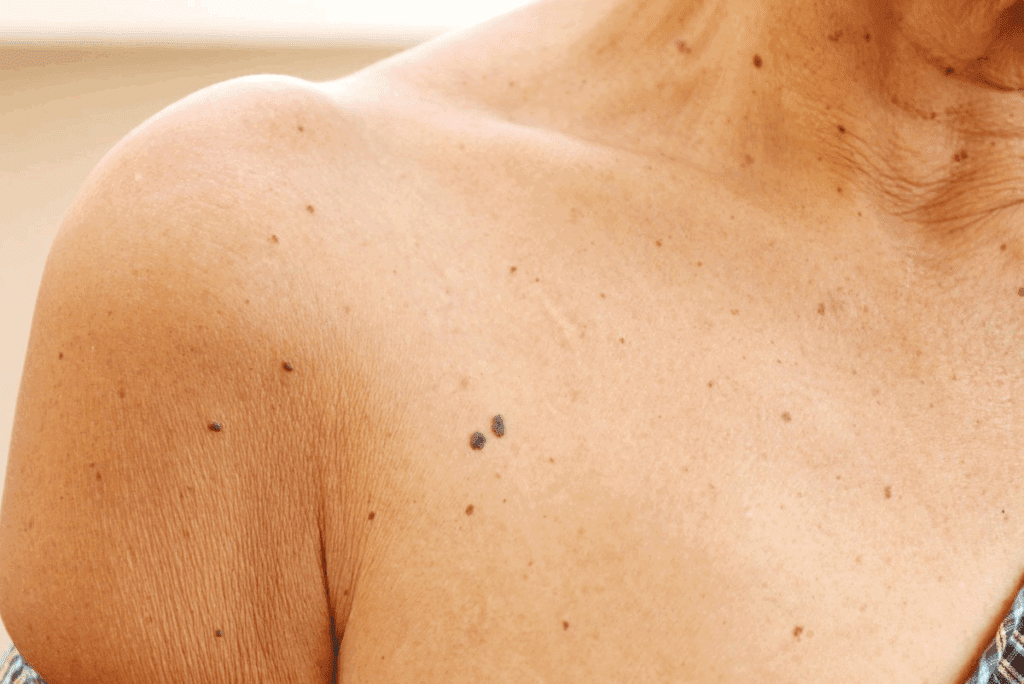Last Updated on November 27, 2025 by Ugurkan Demir

Skin cancer is a growing concern, with basal cell carcinoma being the most common form worldwide. We are committed to helping you recognize the early signs to ensure timely treatment.
With an estimated 3.6 million cases diagnosed annually in the United States, it’s important to know the signs. Look for pearly pink bumps and scaly patches on sun-exposed areas.
Early detection can make a big difference. We will guide you through the essential signs to look out for. We also provide resources to help you identify skin cancer early.

It’s important to know about basal cell carcinoma for early detection and treatment. This type of skin cancer is the most common worldwide.
Basal cell carcinoma (BCC) starts in the skin’s basal cell layer. It grows abnormally and can spread if not treated. BCC grows slowly and rarely spreads, but it can damage the skin if not treated quickly.
The exact cause of BCC is not known. But, UV radiation from the sun or tanning beds increases the risk. Genetics and certain skin conditions also play a part.
The American Cancer Society says BCC is the most common skin cancer. It makes up about 70-80% of all skin cancers. The number of BCC cases has gone up, with millions diagnosed each year in the U.S.
Finding BCC early is key for effective treatment and less damage. Early detection means better treatment options like surgery or topical treatments.
Waiting too long can mean more complicated treatments. This can lead to scarring and disfigurement. Rarely, BCC can spread deeper and even metastasize.

Knowing the signs of basal cell carcinoma is key to catching it early. This type of skin cancer is the most common. Spotting its signs can help in getting the right treatment.
Basal cell carcinoma often looks like flesh- or pink-colored bumps. These bumps might have visible blood vessels and can be shiny. They might also have a rolled edge, making them stand out.
Their look can change, but they usually have certain traits. These include:
Basal cell carcinoma often shows up in sun-exposed areas. The most common spots are:
| Location | Frequency |
| Face | High |
| Neck | Moderate |
| Arms | Moderate |
| Scalp | Low to Moderate |
These areas get more sun, which increases the risk of BCC.
Basal cell carcinoma grows slowly. It starts as a small, painless bump. If not treated, it can grow and damage nearby tissues. But, it rarely spreads to other parts of the body.
The way BCC grows can differ. But it often:
Spotting it early is important to avoid serious damage and ensure the best treatment.
Basal cell carcinoma comes in different forms, with nodular basal cell carcinoma being common. It has a unique look and grows slowly.
Nodular basal cell carcinoma looks like a firm, round, and raised growth. It has a smooth surface and can look pearly or translucent. These spots are often pink, red, or flesh-colored and might show blood vessels.
Studies show that the nodular type makes up a big part of basal cell carcinoma cases.
“Nodular BCC is characterized by its well-defined margins and a tendency to bleed or crust.”
Nodular basal cell carcinoma often shows up on sun-exposed areas like the face, ears, and neck. It can also appear on other parts, like the fingers, but that’s less common.
| Location | Frequency |
| Face | High |
| Ears | Moderate |
| Neck | Moderate |
| Fingers | Low |
The image shows a typical lesion on the face, looking raised and firm.
When looking at skin cancer pictures, like nodular basal cell carcinoma, look for the key features. Catching it early can lead to better treatment results.
For more on skin cancer and its types, see a dermatologist. They can offer advice and treatment plans tailored to your situation.
It’s important to spot superficial basal cell carcinoma early. It looks like a flat, scaly patch on the skin. This skin cancer is often hard to notice, so watch for any skin changes.
Superficial basal cell carcinoma looks like a flat or slightly raised reddish patch. It might have a scaly surface and look like eczema or dermatitis. The growth is slow and can bleed or crust over time.
Look out for these signs:
This type of skin cancer often shows up on sun-exposed areas. These include the chest, back, and shoulders. It can also be found on the face, like the nose, forehead, and cheeks.
Let’s look at some pictures to understand superficial basal cell carcinoma better. The image below shows what it looks like.
The image shows a flat, reddish patch with a scaly surface. If you see any unusual skin changes, see a dermatologist.
| Characteristics | Description |
| Appearance | Flat or slightly raised reddish patch |
| Surface | Scaly or crusty |
| Growth Rate | Slow-growing |
| Common Locations | Chest, back, shoulders, face |
Morpheaform basal cell carcinoma is hard to spot because it looks like a scar. It’s a type of basal cell carcinoma that can be missed because it’s not obvious.
This type of basal cell carcinoma looks like a firm, white or yellowish plaque. It’s flat or slightly depressed and has unclear edges. The surface might look shiny or tight.
Key characteristics include:
Morpheaform basal cell carcinoma is often mistaken for something else because it doesn’t look like typical basal cell carcinoma. It’s subtle, making it hard to find without a close look.
Knowing the risk factors and doing regular skin checks is important. This helps catch any suspicious spots early.
Looking closely is key to spotting morpheaform basal cell carcinoma. Here’s what it usually looks like:
Comparing it to other skin conditions helps understand its unique look.
| Condition | Appearance | Common Locations |
| Morpheaform BCC | Firm, white or yellowish plaque | Sun-exposed areas, often on the face |
| Scar | Flat, may be pink or white | Anywhere on the body |
| Dermatitis | Red, inflamed, may be itchy | Various, often on hands or face |
Knowing the differences is important for correct diagnosis and treatment.
Pigmented basal cell carcinoma is a type of skin cancer that looks like melanoma. It has pigment, making it hard to tell apart from other skin spots.
Pigmented basal cell carcinoma has certain signs that help identify it. These include:
It’s important to remember that pigmentation is a key feature. But, it’s not always there. And not having pigmentation doesn’t mean it’s not basal cell carcinoma.
It can be hard to tell pigmented basal cell carcinoma from melanoma because they look similar. But, there are some differences:
Seeing a dermatologist is key for a correct diagnosis. They can do a detailed check and, if needed, a biopsy to figure out what the spot is.
Looking at pictures is important for diagnosing pigmented basal cell carcinoma. Images of skin cancer on stomach or other areas can show its different forms.
Pigmented basal cell carcinoma can look like a darkly pigmented nodule or plaque. It might have a shiny surface. The color can be the same all over or different in spots. It can even look like a melanoma scalp photo, making it important to look closely.
Knowing how skin cancer looks is key for catching it early. By learning about the different types, like pigmented basal cell carcinoma, people can spot problems sooner and get help faster.
Rare types of basal cell carcinoma, like ulcerated and basosquamous carcinoma, are tough to diagnose and treat. They can cause a lot of damage and disfigurement if not treated.
Ulcerated basal cell carcinoma is a rare and aggressive type. It has ulcers or open sores. It’s hard to diagnose because it looks like other skin problems. Early detection is key to avoid more damage and get better results.
“Ulcerated basal cell carcinoma needs quick medical care,” says Medical Expert, a top dermatologist. “If not treated, it can cause a lot of harm and affect the patient’s life quality.”
Basosquamous carcinoma is a rare type of basal cell carcinoma. It has traits of both basal cell and squamous cell carcinomas. This aggressive tumor grows fast and can spread, making early detection and treatment very important.
Looking at the skin is key in diagnosing advanced and rare basal cell carcinomas. The images below show what ulcerated basal cell carcinoma and basosquamous carcinoma look like.
These pictures show why it’s important to know the signs and symptoms of advanced basal cell carcinoma. If you see any unusual skin changes or growths, see a dermatologist right away.
Knowing the risk factors for basal cell carcinoma is key to preventing it. By understanding these factors, we can take steps to lower our risk. We can also get medical help early if needed.
Some people are more likely to get basal cell carcinoma. These include those with light skin, a lot of sun exposure, and a family history of skin cancer. Fair skin, light hair, and light eyes also increase the risk because they have less melanin. Melanin helps protect against UV rays.
Studies show that people who spend a lot of time in the sun, or who have had sunburns, are at higher risk. UV rays can damage skin cells’ DNA, causing cancer.
Sun exposure is a big risk for basal cell carcinoma. UV rays from the sun or tanning beds can harm the skin, leading to cancer. Here are some ways to protect yourself:
The American Academy of Dermatology says sun protection is essential to prevent skin cancer. By following these tips, we can lower our risk of basal cell carcinoma.
Genetics also play a part in basal cell carcinoma. Certain genetic conditions, like Basal Cell Nevus Syndrome (Gorlin Syndrome), raise the risk of getting many basal cell carcinomas early in life.
| Genetic Condition | Characteristics | Risk Level |
| Basal Cell Nevus Syndrome | Multiple BCCs at a young age | High |
| Xeroderma Pigmentosum | Extreme sensitivity to UV light | Very High |
| Albinism | Lack of melanin production | High |
Regular skin checks are important for catching basal cell carcinoma early. We suggest doing self-exams every month and getting professional checks once a year, if you’re at high risk.
“Early detection is key to treating basal cell carcinoma effectively. Regular skin checks can help identify suspicious lesions before they become dangerous.”
— American Cancer Society
By knowing the risk factors and taking steps to prevent them, we can lower the number of basal cell carcinoma cases. This can also improve treatment results.
Early detection and proper treatment of basal cell carcinoma lead to good outcomes. We’ve looked at the different types of basal cell carcinoma, their features, and why it’s key to spot them early.
If you think you might have skin cancer or see any odd skin changes, it’s important to know when to see a dermatologist. A dermatologist can check your skin, give a proper diagnosis, and suggest the best treatment.
Regular skin checks and protecting your skin from the sun are key to preventing skin cancer. We urge you to take care of your skin and get medical help if you have any skin cancer concerns.
Basal cell carcinoma on the face can show up as a shiny bump. It might also look like a pink or red patch. Or, it could be an open sore that doesn’t heal.
It can also resemble a scar-like area. Or a firm, flat area that’s pale or yellow.
Skin cancer on the arm might look like a new or changing mole. It could also be a sore that doesn’t heal. Or a shiny bump.It might appear as a red or pink patch. Or a firm, flat area.
A light pink spot on the scalp could be basal cell carcinoma or another skin issue. It’s important to see a dermatologist for a correct diagnosis.
The most common face cancer is basal cell carcinoma. But there are also squamous cell carcinoma and melanoma.
We can’t show images here, but skin cancer on the stomach might look like a new or changing mole. It could also be a sore that doesn’t heal, or a shiny bump.It’s best to talk to a dermatologist for guidance.
Skin cancer on fingers might look like a new or changing mole. It could also be a sore that doesn’t heal, or a shiny bump.It might appear as a red or pink patch.
Basal cell carcinoma on the head can show up as a shiny bump. It might also look like a pink or red patch. Or an open sore that doesn’t heal.It can resemble a scar-like area. Or a firm, flat area that’s pale or yellow.
Risk factors include a lot of sun exposure and fair skin. Genetic predisposition and a history of skin cancer also increase the risk.
Basal cell carcinoma often looks like a shiny bump or a pink or red patch. Melanoma usually appears as a new or changing mole.It’s best to consult a dermatologist for a proper diagnosis.
World Health Organization. (2025). 7 Basal Cell Pictures Recognize Skin Cancer Signs. Retrieved from https://www.who.int/news-room/q-and-a/detail/sun-protection
Subscribe to our e-newsletter to stay informed about the latest innovations in the world of health and exclusive offers!